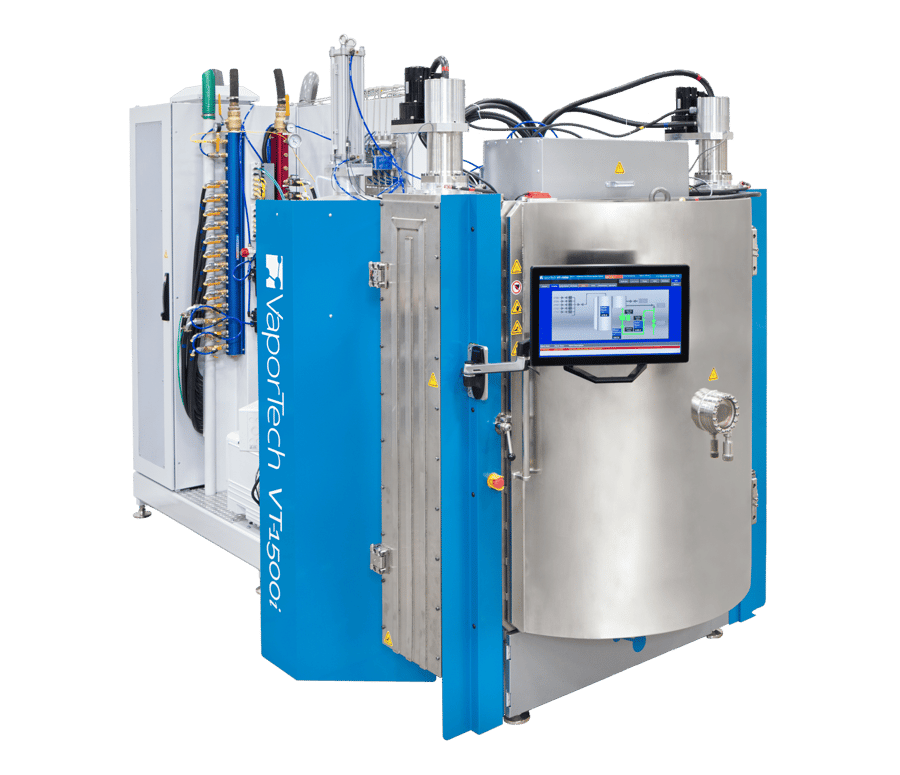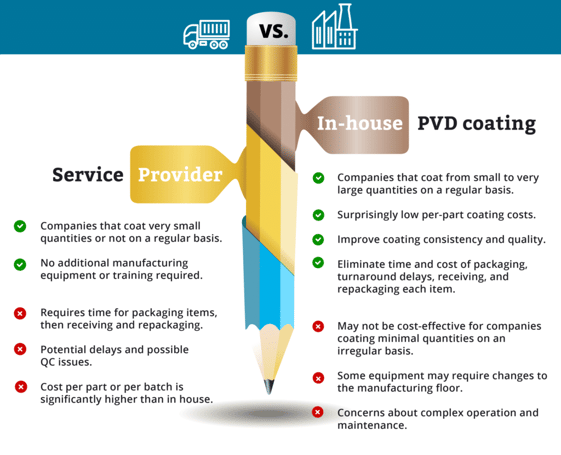In-House PVD Coating vs. Outsourcing Costs: Choosing the Right Solution
Quick Answers
- In-house PVD coating equipment is cost-efficient when integrated into your manufacturing and QC processes.
- Cost savings from in-house PVD coating come from very low per-part coating costs, streamlined production, time savings, and quality control.
- Compare PVD coating systems by asking detailed questions to ensure your system has all the features and capabilities you need.
Watch our "Learn from the Experts" video: PVD Coating Costs - The Bottom Line.
It's all about the ROI
If you want your products to benefit from superior coatings, you can outsource PVD (physical vapor deposition) coating to a service provider or invest in PVD coating in-house. Third-party coating service providers own coating equipment and will coat your parts and products along with those of their other customers. You must package, send, wait for, and receive products before repackaging for sale. In-house coating equipment is integrated into your manufacturing and QC process and requires purchasing capital equipment. This investment can be cost-effective, depending on your coating needs. Here’s how to make the right decisions.
Make parts and products more functional, durable, and beautiful
Before we get into the details about the pros and cons of bringing PVD coating in-house, here is a brief introduction to PVD coatings. Thin-film deposition is often referred to as “PVD coating,” but in fact, PVD is only one of several processes that are used, which also include CVD (chemical vapor deposition) and DLC (diamond-like carbon) coatings. PVD & DLC coating systems deposit metal-based coatings to many metal or plastic parts and products. Thin-film coatings are bonded to the substrate at the atomic level.
- These coatings are so thin that they do not impact dimensional tolerance and do not mask desired textures in the substrate.
- They are fade-resistant and consistent, and they often outperform other coating technologies.
Are you unsure whether you should coat in-house or outsource? Contact us today, and we can help you make the right decision.
Consider your company’s needs
Many coating service providers offer PVD and CVD coating services for customers manufacturing architectural hardware (faucets and knobs), automotive parts, medical devices, cutting tools, molds & dies, firearms, blades, and other parts and products. Service provider users will manufacture up to the coating stage, package their items, and send them to a provider. The provider coats the items, repackages them, and returns them to the manufacturer. The parts are unpacked, returned to the manufacturing line, and repacked for shipment.
Manufacturers who coat parts regularly often purchase PVD coating equipment to bring in-house. Depending on company size, coating quantities, and desired coating types, these manufacturers must choose the right machine to fulfill their exact needs and provide the coating results required. Some coating equipment companies offer a standard color and coating composition chart. We create optimized coatings at Vapor Technologies (VaporTech®) to meet our customers’ product specifications or match legacy finishes.
Tips for choosing the right PVD coating system
Before you choose a system:
- Find out what types of coatings your system can produce. If you introduce a new product or color, will it be challenging to use the same machine? Can you use it for PVD and DLC coatings?
- Determine whether your desired system comes with your choice of standard coatings or with the R&D expertise to create custom coatings.
- Ensure the system is right-sized to meet your needs; don’t invest more (or less!) than you need to.
- Ensure the system footprint is small enough to integrate into your facility easily.
- How easy is the system to purchase, install, operate, and maintain?
- Does the company have the resources to support you from coating development to service throughout the life of your system?
.png?width=445&height=297&name=in%20house%20or%20outsource%20blog%20header%20(1200%20x%201000%20px).png)
You can download an easy-to-read graphic PDF guide on choosing between in-house and outsourcing.
Whether you are looking at systems or looking for a good service provider (we have good ones we recommend!), please contact us by email or call us at 303-652-8500.
Recent posts

No Ph.D. Required: VaporTech Machines Make the PVD Coating Process Easy
-1.png?width=900&name=Blog%20banners%20(2500%20x%20625%20px)-1.png)
PVD Coating Durability: Does PVD Coating Wear Off?






